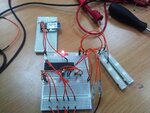amitaiwe
Member level 3
Hi to all,
I have build a metal detector circuit based on this idea:
https://www.micro-examples.com/public/microex-navig/doc/076-picodetector.html
I'm using a PIC16F877 and a Bluetooth module RN42SM.
I implemented the detector by oscillating a PWM wave via the PIC,
sending it through an inductor, capturing the frequency at the timer1
and transmitting the data via the BT module to a PC.
Up till now the timer's value slightly changes and doesn't give a good indication
for metal detecting. Does somebody have any ideas of how to improve the
detecting?
I tried changing the frequency's value (521-15000hz) and changing the
captures specifications for flag interrupt between every 4-16th rising edge.
Thanks, Amitai

I have build a metal detector circuit based on this idea:
https://www.micro-examples.com/public/microex-navig/doc/076-picodetector.html
I'm using a PIC16F877 and a Bluetooth module RN42SM.
I implemented the detector by oscillating a PWM wave via the PIC,
sending it through an inductor, capturing the frequency at the timer1
and transmitting the data via the BT module to a PC.
Up till now the timer's value slightly changes and doesn't give a good indication
for metal detecting. Does somebody have any ideas of how to improve the
detecting?
I tried changing the frequency's value (521-15000hz) and changing the
captures specifications for flag interrupt between every 4-16th rising edge.
Thanks, Amitai
